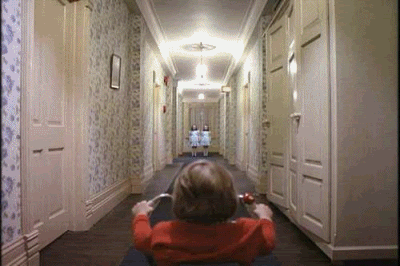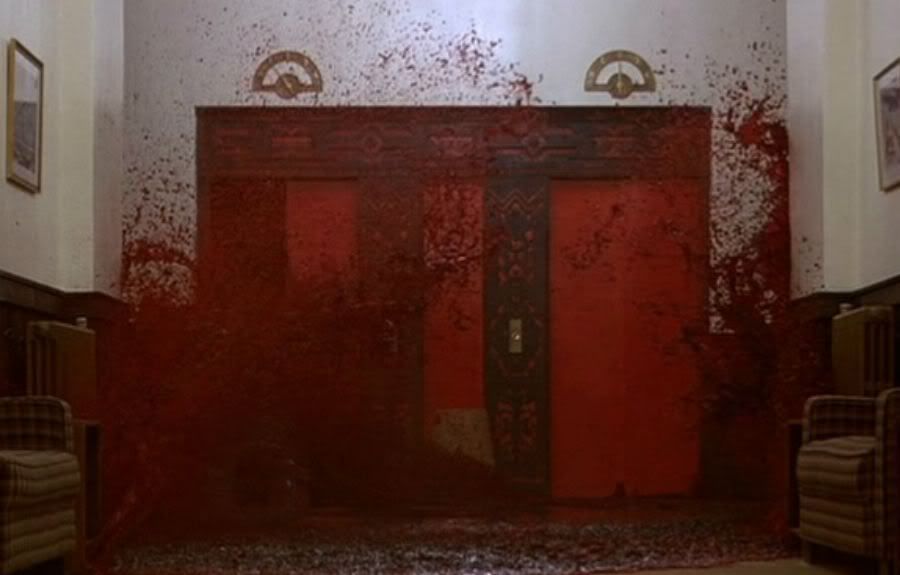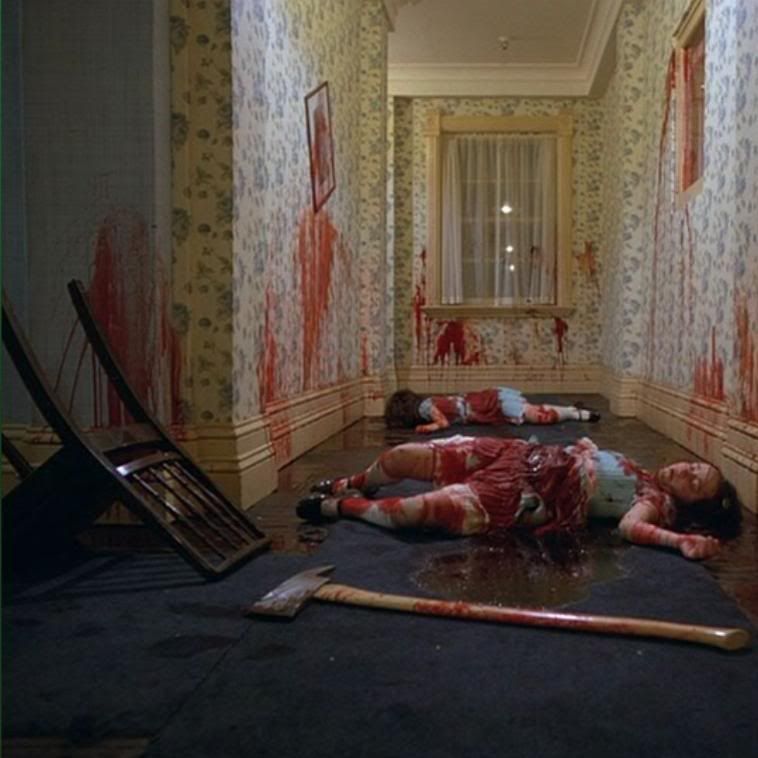


 I've just come across this intriguing review of Geoffrey Cocks's The wolf at the door: Stanley Kubrick, history & the Holocaust. Thomas Caldwell argues that the book would have worked better had it concentrated more exclusively on The Shining, because it is very convincing in that regard in teasing out Kubrick's preoccupation with The Holocaust (his other project, The Aryan Papers, was never realised, and Kubrick reserved a telling critique of Spielberg's Schindler's List as not really amounting to a Holocaust film, because it was about survivors). Caldwell argues that Cocks overextends this thematic in his reading of Kubrick's other works, for the most part, with a few notable exceptions, such as the title character of Dr. Strangelove. Here is one of the more telling passages from the review:
I've just come across this intriguing review of Geoffrey Cocks's The wolf at the door: Stanley Kubrick, history & the Holocaust. Thomas Caldwell argues that the book would have worked better had it concentrated more exclusively on The Shining, because it is very convincing in that regard in teasing out Kubrick's preoccupation with The Holocaust (his other project, The Aryan Papers, was never realised, and Kubrick reserved a telling critique of Spielberg's Schindler's List as not really amounting to a Holocaust film, because it was about survivors). Caldwell argues that Cocks overextends this thematic in his reading of Kubrick's other works, for the most part, with a few notable exceptions, such as the title character of Dr. Strangelove. Here is one of the more telling passages from the review:"Much of The wolf at the door is background material for Cocks' ultimate argument that The shining is Kubrick's Holocaust film.
Stanley Kubrick wanted to make a film about the Holocaust. Stanley Kubrick never made a film about the Holocaust. Until he did. It was not the film he said he would make. But it is the one he made. (172)
After so much build up the final chapters do provide a rigorous and fascinating reading of The shining as a text on the Holocaust. Cocks explores the cultural significance of the hotel as setting and the symbolism of the typewriter as "the primary weapon of the SS bureaucrats of the Final Solution who have rightly been designated 'desk murderers'". (188) Cocks discusses the inter-textual references The shining contains from literature such as Thomas Mann's 1924 novel The magic mountain, Joseph Conrad's 1902 novel Heart of darkness and the novels of Franz Kafka. Some of the many films that Cocks contrasts The shining with include The 1000 eyes of Dr. Mabuse (Fritz Lang, France/Italy/West Germany, 1960), The exterminating angel (Luis Buñuel, Mexico, 1962), The night porter (Liliana Cavani, Italy/USA, 1974) and even Barton Fink (Joel and Ethan Coen, USA/UK, 1991), which Cocks convincingly argues is a homage to The shining. Cocks examines the nursery rhymes that are evoked, the psychoanalytical meaning of the maze in regard to the female body and the role of the child in Kubrick's films. Cocks' eye for detail is extraordinary and after finishing The wolf at the door it is difficult not to think of the blood pouring out of the elevator as the blood of the millions murdered in the Holocaust. Likewise, it becomes clear why audiences have previously associated the Grady twins with the 'medical research' done by Dr. Joseph Mengele on twin children at Auschwitz".
Stanley Kubrick wanted to make a film about the Holocaust. Stanley Kubrick never made a film about the Holocaust. Until he did. It was not the film he said he would make. But it is the one he made. (172)
After so much build up the final chapters do provide a rigorous and fascinating reading of The shining as a text on the Holocaust. Cocks explores the cultural significance of the hotel as setting and the symbolism of the typewriter as "the primary weapon of the SS bureaucrats of the Final Solution who have rightly been designated 'desk murderers'". (188) Cocks discusses the inter-textual references The shining contains from literature such as Thomas Mann's 1924 novel The magic mountain, Joseph Conrad's 1902 novel Heart of darkness and the novels of Franz Kafka. Some of the many films that Cocks contrasts The shining with include The 1000 eyes of Dr. Mabuse (Fritz Lang, France/Italy/West Germany, 1960), The exterminating angel (Luis Buñuel, Mexico, 1962), The night porter (Liliana Cavani, Italy/USA, 1974) and even Barton Fink (Joel and Ethan Coen, USA/UK, 1991), which Cocks convincingly argues is a homage to The shining. Cocks examines the nursery rhymes that are evoked, the psychoanalytical meaning of the maze in regard to the female body and the role of the child in Kubrick's films. Cocks' eye for detail is extraordinary and after finishing The wolf at the door it is difficult not to think of the blood pouring out of the elevator as the blood of the millions murdered in the Holocaust. Likewise, it becomes clear why audiences have previously associated the Grady twins with the 'medical research' done by Dr. Joseph Mengele on twin children at Auschwitz".

I've found an interesting companion piece to Cocks. What I like about it is that it builds a highly detailed, and very original, case for the temporal logic/method of the film as a reflexive statement about apocalypse. The use of Mayan references by this blogger, to my mind, does nothing to downplay any parallels with the genocidal themes that Cocks brings to light. If anything, they are complementary. Having read the Fred Jameson, Douglas Kellner and Michael Ryan interpretations, it is refreshing to read something very different, as it reminds us of the true significance of "reader response criticism", whilst profoundly reaffirming the cultural/historical legacy of The Holocaust: the gas chamber, rather than the Weberian iron cage, becomes the metaphor of the dark side of modernity.
I hadn't felt so rewarded by a reading of a Kubrick film since Metaphilm's piece on Eyes Wide Shut, which included a fascinating link to The Konformist, where the film becomes a hardcore conspiracy narrative.I worry about the seemingly arbitrary nature of some readings, but The Shining has proved a welcome companion piece to Adam Roberts's Science Fiction, which comments in effect on some of the iconography used for this blog, although I stress that any collusion on my part was purely unintentional (here I cite his description of the racial coding of the Alien and Predator films; gender aspects are, of course, also examined, elsewhere in the text):
"Ridley Scott’s Alien (1979) represents the alien as a black-skinned monster—played, in the original film, by a black actor in a suit—who lurks in the bowels of the industrial ship, a symbol of the industrial city, killing via a ghastly combination of rape and violence. It doesn’t take much cultural decoding to see this as an expression of white middle-class fear at the potential for distrust of an alienated black urban underclass. In John McTiernan’s Predator (1987), the savage hunter alien has dreadlocks, a clear enough signifier of blackness. He inhabits the jungle, preying violently and barbarically on the ‘Western’ colonisers, be they American, ‘Dutch’ or Hispanic. He also, when he finally uncovers his face at the end of the movie, has a peculiar mouth with teeth that look like bones pierced through his face—another ‘jungle man’ caricature of racial blackness. The coding is made even more explicit in the sequel, when the action relocates from the jungle to the urban battlefield of Los Angeles, another, more politically loaded location for white fears of black violence, with the alien joining in the gang war. In the first film, the Predator is destroyed by the Aryan übermann Arnold Schwarzenegger. In the second, the casting is even more ingenious: the black actor Danny Glover is pitted against the black-man-as-alien, precisely in the scene where black-on-black violence in contemporary America is at its most acute" (2000, pp 119-120).



No comments:
Post a Comment